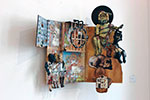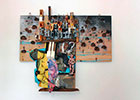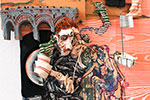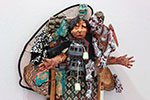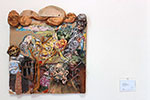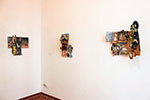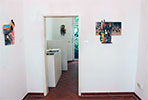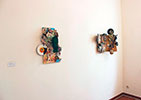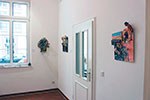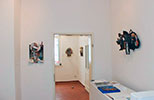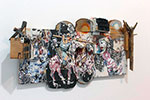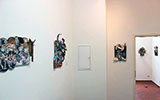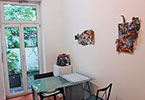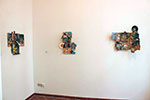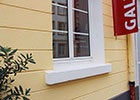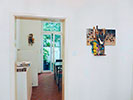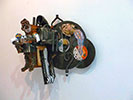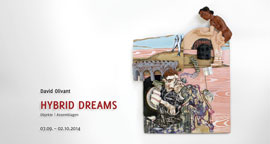David Olivant
After CADENZA in 2007, JANZEN Gallery for the second time presents works of David Olivant, California-based artist and professor for painting. We show pieces from his new group of works HETEROGLYPHS: Assemblages of wood, ceramics, plastic, cardboard and paper, mounted on wooden panels, forming bizarre, sometimes apocalyptic scenes coevally attracting and disgusting, bewitching and confusing. At first sight, David Olivants objects are not comprehensible. Grotesque figures – half-human, half-animal creatures – landscape, architecture and technics – everything merges and disassembles.
Drawing from the imagery of late Middle Ages and Northern Renaissance, David Olivant masterfully creates complex contemporary dramas with delight in detail; a scenery based on deep symbolism and many layers of allegories and analogies. His compositions are distortions of the present.
David Olivant, born 1958 in Watford/England, studied painting at Royal College of Art, London, inter alia with Ronald B. Kitaj. Master student. Three-year sojourn in Indien, followed by studies in Sweden. Several solo and group Exhibitions since 1987.
Works in public collections,inter alia Fullerton Museum, California State University; San Bernardino/USA, Huntington Art Gallery, University of Texas, Austin/USA; Art Institute of Chicago/USA; British Council, London/GB.
David Olivant lives in California/USA for more then 25 years now and works as a professor for Fine Arts since 1995 at California State University Stanislaus/USA.
See also
Opening speech given by Dr. Andreas Steffens at our first exhibition with David Olivant (CADENZA | Pastel Drawings on Paper | 2007): http://musenblaetter.de/artikel.php?aid=1332
Addition to exhibition catalogue HETEROGLYPHS | Essay by David Olivant
Heteroglyphs.
For years I have scoured and interrogated unconscious imagery, arrived at through the outmoded surrealist practice of automatic doodling, and the quasi narratives into which it sometimes coheres, for hints of meaning, seeing these configurations as allegories that somehow root the wellbeing of my psyche in that of the cosmos as a whole. In recent work and in response to the apparent limitations of a linear, temporal narrative, no matter how multivalent, a distinctly different narrative has emerged. The interactions between characters were taking on an autonomy that somewhat subverted or transcended my own time-worn agendas. The characters behaved out of apparent embryonic self-awareness in scant regard for my designs on their careers. Instead of addressing each other and fulfilling their roles in the plot they adopted an outward mode of address, directly engaging, or even patently avoiding, myself or my proxy (the viewer).
The stylistic and methodological consequences of this have been radical. The literal, physical connections between the solids of which the figures are generally composed and the flat picture surface come to represent for me a point of intersection or contact between distinct, heterogeneous worlds, and in doing so they transfer the weight of meaning from transactions across the surface to transactions between the surface and what sits in front of it. Meaning is effectively deepened through the interaction of real and illusory space. It might justly be claimed that historically almost any relief sculpture, whether by Ghiberti, Veit Stoss or the carvers of The Descent of the Ganges in Mahaballipuram has more than adequately explored this turf. I would concur with this but with the following proviso- in all of these works and others of their time there is a largely seamless absorption of the sculptural elements into the painted illusion or vice-versa, but rarely have the interactions or contacts between the realm of sculpture and the realm of painting been viewed as the pivot of meaning. A possible exception might be found in parts of the Isenheim Altarpiece (actually, largely a painting) but here it is more that some of the painted elements act like sculpture or magically transform into it, so that the typical seamlessness of relief sculptures now appears to be the result of enchantment. Furthermore, and if we take Grunewald as instructive, what in his depictions allows for layers of allusion through the resemblance of one substance or object to numerous others in a phantasmagoric feeding frenzy, never quite reaches the next logical stage of having the figures actually built of those other things or substances. In his case it would look inelegant, irreverent or absurd. If the limbs of the crucified Christ remind us of tree limbs they are nonetheless never made of tree limbs or even described as such.
So, if the mode of address is outward into the viewer’s space, and if the collision of the picture surface and sculpted elements represents a contact between discrete contradictory worlds, and if the discrete elements of which the characters are constructed convey their literal or primary identity (as fan blade, shell, driftwood etc.) with as much force as their secondary or signifying identity (as airplane wing, human thorax, beard-hair etc.) then the traditional linear narrative is at the very least seriously undermined by these other more assertive carriers of meaning. This type of meaning is ineluctably elusive and open- ended and invites the sarcastic, derisory, flippant, ironic or generally less than sincere or well-behaved terms in which I have commentated on each image later in this catalogue.
So much for the stylistic consequences… My standard operating procedure between 1980 and 2008 had involved the extraction from a laboriously layered surface (in the case of paintings) or a greatly pummeled and massaged mound of clay (in the case of sculptures) of imagery that, while it suggested multiple meanings, was usually tightly interwoven and somehow all of a piece. I viewed the separation of my work into two distinct categories, the sculptural and the painterly, as somehow artificial and around 2008 I began to add ceramic components, usually heads and limbs, to a flat, painted support. One vague inspiration for this was certain medieval Limoges enameled boxes where the heads of figures protrude, albeit elegantly, from an otherwise flat surface. My initial experiments with hybridizing painting and sculpture failed to inspire until my wife, Katie, pointed out to me that the ceramic figures seemed to be either attempting escape from or entry into the flat, painted world of the wooden panels to which they were affixed. I am grateful to her for kick-starting my recognition of this completely novel dimension of meaning.
I made a number of pictures between about 2008 and 2011 that explored the possibilities inherent in my first work of this type pretentiously titled “Polyptych of Ontological Discontents”. For these large panels I produced ahead of time a number of complete low-relief ceramic figures that were then attached to plywood boards and generated painted partners or antagonists on them. This was largely a case of rotating the axis of the narrative through ninety degrees so that it was now perpendicular to rather than parallel with the picture surface, but this axis never projected more than an inch or two from the surface. During this time I also gradually fastened other sculptural components to the surface, mostly pieces of driftwood. The two-dimensional surface, under the impact of the apparent collision with ceramic relief figures started to rupture and collage became the predominant mode of adding painterly elements.
It was a relatively small step from this to creating greater fragmentation and heterogeneity in the sculpted forms and in this sense “The Wrong Trousers” 2010 was something of a departure for me. The range of objects now included, in addition to ceramic heads and breasts, two fan blades, driftwood and a flat stone functioning as a speech bubble. The fact that the metaphors generated by the conjunction of different recognizable objects with the forms they depicted, in this case, for instance, painted driftwood and a pair of trousers, now occupied the literal foreground of the viewer’s attention, afforded the more traditional pictorial narrative a subservient and, for me, less insistently autobiographical role. This freed it up to function as a sort of comic or sarcastic melody (in the manner of Shostakovich) against which the darker, more pervasive imaginative themes could be played out.
So now (now being around 2011) rather than standing for weeks confronted by an ever thickening skein of abstract shapes and squiggles from which I eventually lifted images that carried some resonance or suggestions of meaning, I was situated amidst legions and cohorts of ceramic heads, and other body parts, in addition to miniature ceramic building facades and anything else in ceramic I thought might come in handy. These would have been built over a period of a few weeks, fired and then stockpiled, like the parts of a kit for building a future universe. In the meantime I would also have haphazardly collected discarded toys, pieces of driftwood, electrical and plumbing components, kitchen tools, hairdryer parts, piano parts, humidifier parts and other detritus of 21st century existence. In this I was influenced by the practices of my friend, the artist Gordon Senior, with whom, despite our mutual interest and affinity, I was never able to collaborate (my fault, not his) except in this much more removed sense. It was now as if the potential images from my unconscious were pre-fabricated ready to be combined at will, in a kind of oneiric assembly–kit. But in fact it was more than this because many of the fragments, take for instance the plastic business end of a potato masher, had lost most of their original identity, not least because I dismembered them. This now functions as the façade of a building in “One in the Eye” It was for me a revelation that the conjunctions of different components of the everyday world could be more original and project wider spectrums of meaning than what I had for years so laboriously gleaned from layered and abraded automatic doodling. This conjunctions are best described by the neologism “heteroglyph” after which the exhibition is named.
In “Lightening Strikes Twice” we see a male figure built partly from a glass light cover, its crenations mimicking those of pleated cloth. His arms and shoulders incorporate a piano action bracket, while his truncated genitals are derived from a similarly truncated bronze fan-blade arm. He sports a clay head, made many years ago by my brother, topped by a quasi-renaissance headdress from a plastic humidifier and hair from a bristle brush. The qualities of these elements (hardness, brittleness, plasticity, fragility, weight) dictate the methods by which this heteroglyph is attached to the wooden panel behind, generating the complex relationship between the flat surface and the sculpted components fastened to it. At this stage in my work I was as concerned to undermine the barrier between these two worlds as to illustrate the collisions at their interface. At lower left an elegantly attired lady, not only from the illusory world of painting but from that world as it properly existed c 1680, appears to rescue a younger but ceramic female from imminent drowning, the striations in the wood grain here, as often, standing for aquatic surface ripples. The eponymous lightening is suggested by the black zigzag bridge, salvaged from the same piano as the varnished wood panels. The point of insistently itemizing these details is that the distinct way each component or heteroglyph projects from or adheres to the picture surface and hence to the implied illusory space depicted on it, follows a gamut of nuanced options which, when they are all combined in a single figure whether it be Mr. Lampshade or Mrs. Lightening, invite a meditation on the ontological status of the figure, a status which appears to hover delicately between that of the viewer and that of the larger narrative of which the figure forms a part. I almost revel at the way in which representational expectations are tweaked or sabotaged. In the case of Mrs. Lightening, for instance, everything about the way the rest of the image is constructed might lead to the assumption that her left hand should be most obviously a sculptural component to exaggerate its perpendicular thrust towards the viewer, but instead it is shown drawn in extreme foreshortening. Another strategy that helps complicate the figures’ status is the periodic implied tilting of the orientation of the apparent ground-plane, something I might have picked up from my studies of Indian miniature painting. While what can be seen of the space immediately behind the two large figures tends to recede in obedient single point perspective we seem to look down upon the laminated, varnished wood surface to the left and the green vertical strip behind the image of the young boy. Thus, even where components are attached to the backboard in similar ways they can appear to be different through the implied, not actual, orientation of that same backboard.
I once read that Beckmann’s triptychs are more concerned with the suggestion of meaning than its particular definition. That is, while his images read as starkly allegorical, it is never clear what they symbolize. It might be, that working under Schopenhauer’s heavy shadow, he felt that what he was seeking was ultimately unknowable. My own approach to image making owes much to Beckmann’s example. I hope that through extending the dimensions of my narratives to intercept the real space of the viewer, and through exploring and also subverting the interface between sculpture and painting (more properly between “reality and illusion”) I have anchored the plot lines in something more spatial than temporal and that I have managed to some small degree to undermine the linearity of any narrative and whatever teleology that might imply. I would hope the loosely archetypal personalities that my work delivers can suggest the beginnings of self-consciousness, by doubting their scripted roles and thus directing their attention beyond the linear narrative fabric, to encounter the viewers or their putative author’s story. In this way the autonomy of their distinct egos is actually undermined, as most of these personae are clearly interconnected with everything else around them, built heteroglypically from the fabric of the universe and the associations it evokes. In loosening their author’s grip, in wrestling free of traditional temporal storyline they too appear to seek an intangible form of contact and in so doing mirror his own struggles.
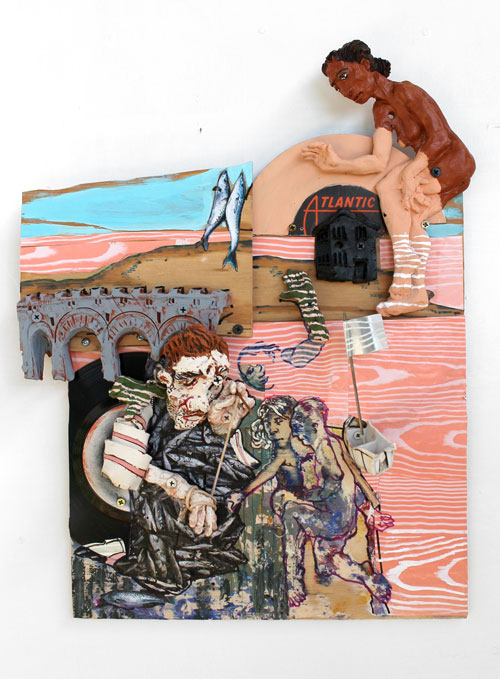
Atlantic Fisheries | 2013 | Object | Assemblage on wood | 45 x 35 cm
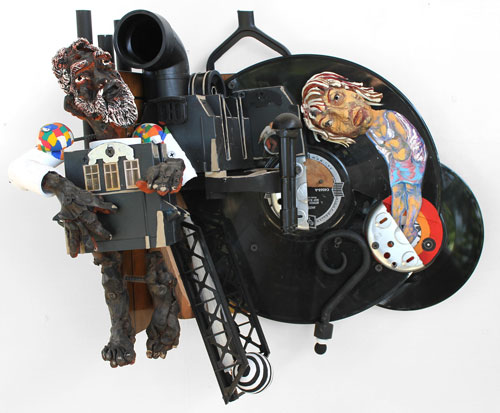
Jazz Jackpots – Between the Devil and the Deep Blue Sea | 2013 | Object | Assemblage on wood | 38 x 40 cm
Views of the exhibition
September 7. – October 1., 2014
HYBRID DREAMS
Objects | Assemblage
Vernissage with the artist in attendence
Sunday, September 7. 2014, 3:00 p.m. – 6:00 p.m.
Introduction: Dr. Andreas Steffens
Opening hours
Wednesday and Friday 3:00 p.m. – 6:00 p.m.,
Saturday 12:00 p.m. – 3:00 p.m.
and by appointment
Special opening hours at the »Hohe-Straße-Fest«
Sunday, September 21st: 1:00 p.m. - 6:00 p.m.
The contents of external links ( ) are subject to liability of the respective provider. External links will open in a new window.
) are subject to liability of the respective provider. External links will open in a new window.

